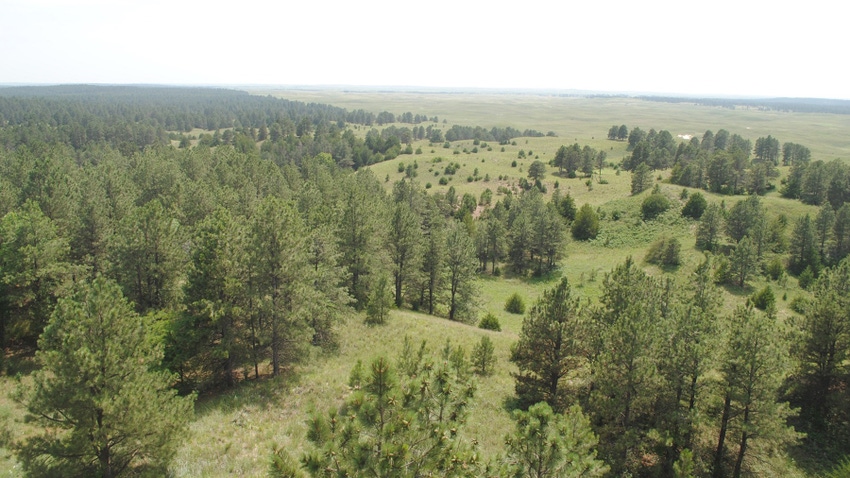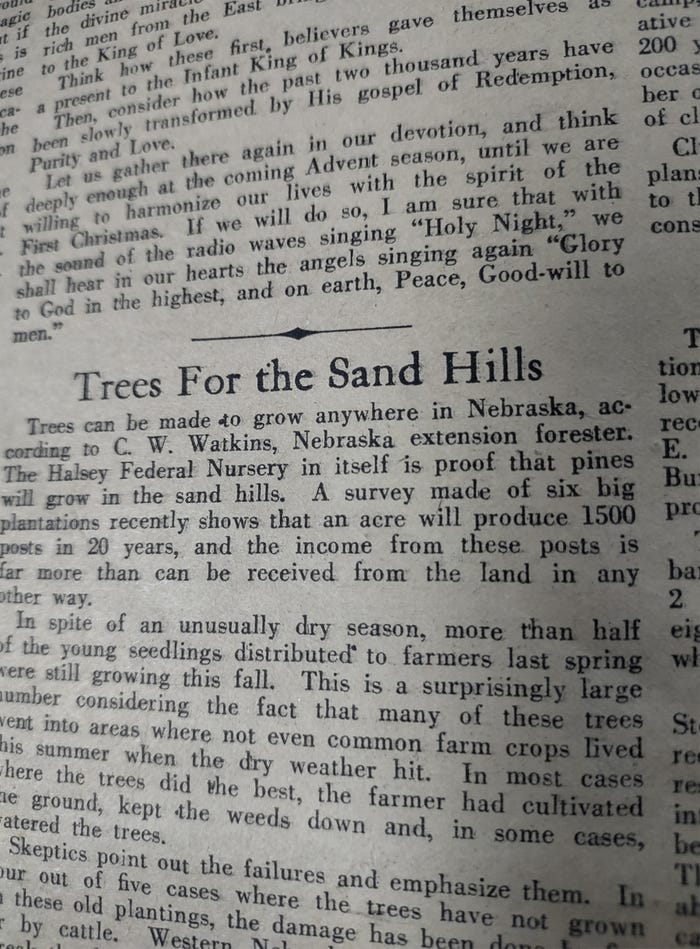
Nebraska didn’t get the moniker of “Tree Planters State” by accident. Looking back at the Dec. 11, 1926, issue of Nebraska Farmer, we found a short article on Page 7, sandwiched between other stories about “Farm Women Study Gas Engines” and “Why Hog Prices Vary,” called “Trees for the Sandhills.”
This article discusses tree-planting efforts in the state, along with lessons learned from the hand-planted forest reserve near Halsey.
In 1891, the Federal Division of Forestry planted an experimental pine plot on a ranch in Holt County, testing whether pine trees would grow in Sandhills soils. Because of the early success of these plantings, two forest reserves — on the Dismal and Niobrara rivers — were designated by President Theodore Roosevelt in April 1902.
By 1908, these were named the Nebraska National Forest, with the Dismal River reserve eventually renamed for the fellow who had the idea, University of Nebraska professor Charles Bessey. The Niobrara reserve eventually became the Samuel McKelvie National Forest — named for the Nebraska Farmer editor, rancher and former Nebraska governor.
National Forest
Since 1903, about 25,000 acres of trees have been planted at the forest near Halsey that this old article discussed. The article used then-University of Nebraska Extension forester C.W. Watkins as a source, saying that the hand-planted pine plantations near Halsey would produce 1,500 fence posts per acre, providing another income stream from the forested land.
It also said that despite dry weather, about half of new tree seedlings planted earlier that same year had survived the summer, with much of the seedling death at the time attributed to wildfire and trampling by cattle.

OLD AD: This ad in the Dec. 11, 1926, issue of Nebraska Farmer talks about the success of the hand-planted forest near Halsey and tree-planting efforts across the state. (Farm Progress)
Another segment of the story discussed the passage by Congress of the Clarke-McNary Act in 1924, authorizing the USDA secretary, in cooperation with state officials, to encourage tree planting and forest protection.
In Nebraska, this quickly led to cooperative efforts between Extension, the UNL College of Agriculture and private nursery businesses to promote and facilitate the planting of more windbreaks and shelterbelts across the Plains.
The demand over the years from farmers and ranchers for what were known as “Clarke-McNary trees” grew. For instance, in 1926, the same year as the article, a total of 33,900 trees went out to 96 cooperators. By 1950, the number grew to 1.151 million trees going to 3,554 cooperators.
Among the earliest trees in the program were Chinese elm, honeylocust, Russian mulberry, Russian olive, maple and wild plum. No doubt, many of those early Clarke-McNary trees still stand across the state, although many early shelterbelts and windbreaks have been removed or are now in need of serious renovation to enhance their longevity and usefulness.
Fire devastation
As for the beloved national forest near Halsey, the Bovee Fire that broke out in early October burned through much of the forest, taking out the equally beloved Nebraska State 4-H Camp facilities and scorching nearly one-quarter, about 5,000 acres, of the Bessey Ranger District and another 14,000 acres of private grassland. Thankfully, Bessey Nursery was spared, but certainly the forest was not.
While the number of conservation trees planted on farms and ranches in more recent years has declined, the need for more of those plantings to protect farmsteads and livestock, to slow wind and soil erosion and to provide adequate habitat for wildlife, has only grown.
We can look back to the article in 1926 to see that the need for conservation trees was recognized then, and hopefully will continue to be acknowledged by producers and landowners in the future.
About the Author(s)
You May Also Like






